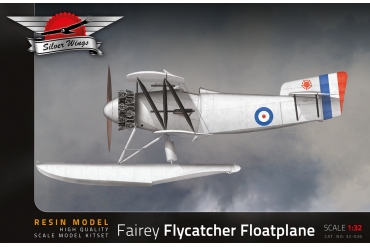Fairey Flycatcher Floatplane (026)
- Cat. No.:
- 32-026
- Material:
- resin
- Scale:
- 1:32
- Period:
- 1923-1934
- Marking options:
- 2x RAF
- Number of parts:
- 185 x resin, 13 x pe, 3 x film
- Length & wingspan:
- 219 x 276 (mm)
- Additional features:
- metal float variant
- Price:
-
History
The Fairey Flycatcher was a British single-seat biplane fighter aircraft, first flown in 1922. Designed by the Fairey Aviation Company, it served primarily with the Royal Navy's Fleet Air Arm. The Flycatcher was notable for its versatility and performance, particularly for its time.
Purpose and Development
The Flycatcher was developed to meet the Royal Navy's need for a reliable and agile carrier-based fighter. It was intended to replace the aging fleet of aircraft that were less suitable for operations from aircraft carriers. To fulfill this role, the Flycatcher was designed with features such as a strong undercarriage for deck landings, arrester hooks, and folding wings for efficient storage aboard ships.
Floatplane Variant
The floatplane version of the Flycatcher was developed to extend the aircraft's operational capabilities to include water landings, which were essential for operations from ships that lacked flight decks or in maritime environments where runways were unavailable. This variant featured pontoons instead of wheels, allowing it to take off and land on water. The addition of floats necessitated modifications to the airframe to maintain stability and performance.
Operational History
The Flycatcher entered service in 1923 and quickly became a favorite among pilots due to its excellent maneuverability and forgiving handling characteristics. The floatplane variant was used in a variety of roles, including reconnaissance, patrol, and as a fighter. It was deployed extensively in the Mediterranean, North Sea, and even the Far East.
The floatplane version of the Flycatcher was particularly valuable in the Mediterranean, where it operated from seaplane tenders and shore bases. These missions included coastal patrols, where the aircraft provided early warning of enemy ship movements and potential threats. The floatplane Flycatchers also took part in gunnery spotting, guiding naval gunfire during exercises and operations.
During its deployment in the North Sea, the Flycatcher floatplane played a crucial role in anti-submarine warfare. Its ability to take off and land on water made it an ideal platform for patrolling vast stretches of ocean, where it could detect and engage enemy submarines. Additionally, the floatplane variant was used for air-sea rescue missions, providing rapid response to downed aircrew and distressed vessels.
In the Far East, the Flycatcher floatplane operated from bases in Hong Kong and Singapore. Here, it was used for reconnaissance missions over the South China Sea and the Indian Ocean, where its presence helped to maintain British naval dominance in the region. The aircraft's versatility and reliability made it a key asset in projecting power and ensuring maritime security.
Legacy
The Fairey Flycatcher remained in service until the early 1930s, by which time it had been largely superseded by more advanced aircraft. However, its impact on naval aviation was substantial, demonstrating the importance of versatility in military aircraft design and the value of incorporating floatplane capabilities for extended operational reach.
In summary, the Fairey Flycatcher, including its floatplane variant, was a pivotal aircraft in the evolution of naval aviation, contributing significantly to the development of carrier and maritime air operations. Its varied and effective use in different theaters of operation highlighted the strategic advantage of having adaptable and reliable aircraft in the Royal Navy's arsenal.






